IDP News Issue No. 10
- Count Otani's Central Asian Expeditions
- Japanese Collections of Dunhuang and Silk Road Manuscripts
- On the Photography of Magistrate Wang and His Family by Wang Jiqing
- Meeting on the Centenary of the Discovery of the Dunhuang Manuscript Cave by Rong Xinjiang
- Conferences
- Websites
- Publications
- Project news
Als PDF herunterladen (660KB)
Count Otani's Central Asian Expeditions
Rong Xinjiang

left:Count Otani in 1901 in London at the age of 26 Photograph from Descriptive Catalogue Selected from Central Asian Artefacts by the Othani [sic] Expeditions Preserved in Ryukoku University Library, Ryukoku University, Kyoto 1989, p.1. Copyright ©Ryukoku University Library
Kozui Otani (1876-1948 )was only 14 when he was sent to London for study. His father was the 21st Abbot of the West Hongan Monastery, headquarters of the Jodo Shinshu -- Pure Land sect of Buddhism -- in Japan. While in Europe Otani had the chance to learn about many of the expeditions to Central Asia and read recently published accounts by Sven Hedin and others. He also became a member of the Royal Geographical Society.
In 1902 he embarked on his own expedition, accompanied by several Japanese monks from Nishi Honganji Temple. Unfortunately, en route he received news of his father's death and had to curtail his travels and return to Japan to take up his position as 22nd Abbot -- becoming Count Otani. His companions continued and only returned to Japan with their finds in May 1904.
The Second Expedition took place between 1908 and 1909 when Zuicho Tachibana and Eizaburo Nomura travelled independently along both the southern and northern routes, investigating many sites. Tachibana set off for the Third Expedition in August 1910. This time both he and Yoshikawa Koichiro - who was sent out later to look for Tachibana - obtained manuscripts from Dunhuang. Yoshikawa stayed in Central Asia until May 1914.
The same month Count Otani resigned his position as Abbot. Financial difficulties led to the sale of his Kyoto residence. The artefacts, manuscripts, plant specimens and even mummies that the Japanese teams had brought back were gradually sold to private and public collections, both in Japan and abroad.
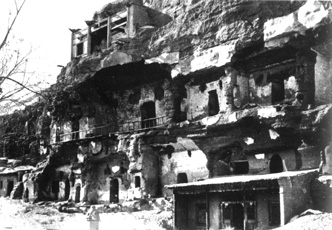
Right:Photograph from the Otani Expeditions The Mogao Caves near Dunhuang, caves 196 and 90 Photograph from Descriptive Catalogue Selected from Central Asian Artefacts by the Othani [sic] Expeditions Preserved in Ryukoku University Library, Ryukoku University, Kyoto 1989, p.1. Copyright ©Ryukoku University Library
The material left in his house, probably several hundred objects, was passed to the new National Museum of Korea in Seoul. Many of the manuscripts still in Otani's possession were moved to Lushun (Port Arthur) in China when Count Otani took up residence there. A 1937 publication lists 639 Dunhuang manuscripts in the Lushun Museum. It is probable that some of the manuscripts were returned to Japan before 1945 when the Communists took control of Lushun, and all but nine of the remaining manuscripts were moved to Beijing in 1954. A large part of the collection remaining in Japan was eventually acquired by Tokyo National Museum.
The same month Count Otani resigned his position as Abbot. Financial difficulties led to the sale of his Kyoto residence. The artefacts, manuscripts, plant specimens and even mummies that the Japanese teams had brought back were gradually sold to private and public collections, both in Japan and abroad.
The material left in his house, probably several hundred objects, was passed to the new National Museum of Korea in Seoul. Many of the manuscripts still in Otani's possession were moved to Lushun (Port Arthur) in China when Count Otani took up residence there. A 1937 publication lists 639 Dunhuang manuscripts in the Lushun Museum. It is probable that some of the manuscripts were returned to Japan before 1945 when the Communists took control of Lushun, and all but nine of the remaining manuscripts were moved to Beijing in 1954. A large part of the collection remaining in Japan was eventually acquired by Tokyo National Museum.
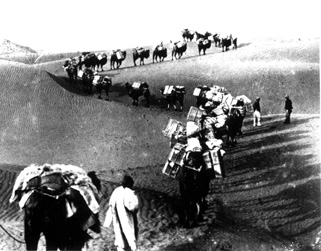
Left:Photograph from the Otani Expeditions. Photograph from Descriptive Catalogue Selected from Central Asian Artefacts by the Othani [sic] Expeditions Preserved in Ryukoku University Library, Ryukoku University, Kyoto 1989, p.1. Copyright ©Ryukoku University Library
Count Otani died in 1948 and the following year two large wooden boxes were discovered at Nishi Honganji Temple containing woodslips, manuscripts and silk paintings. These were moved to Ryukoku University Library along with part of Tachibana's own collection.
Several members of the expeditions wrote diaries, and although these do not generally give details of their excavations, they are still an important record. The original diaries, along with the expedition photographs and plant specimens are now also held by Ryukoku University Library.
In addition to the manuscripts from the Otani expeditions, Japanese museums and collectors continued to purchase manuscripts. For example, over 250 early Chinese and Japanese manuscripts in the Moriya Collection, of which 72 were recorded as from Dunhuang, were donated to Kyoto National Museum. Some of the collections of Chinese bibliophiles were also bought by Japanese institutions and individuals. Manuscripts annotated by Zhang Daqian - who spent several years at the Mogao Caves in the 1950s - for example, is now at Tenri Central Library.
The Japanese collections are therefore various and much more widely dispersed among both public and private holders than the manuscripts in other major collections. In addition, their provenance is not always clear: they have usually passed through several hands and so bear collectors' seals, annotations and different styles of mountings.
There have been numerous publications of both the major and minor collections, but many manuscripts have yet to be published.
A list of the major institutions in Japan with collections of Dunhuang and Turfan manuscripts is given below.
I have made considerable use of Rong Xinjiang's excellent introduction to Dunhuang and Turfan collections for this article: Haiwai Dunhuang Tulufan wenxian zhijianlu, Jiangxi renmin chubanshe, Nanchang 1996.
Susan Whitfield
Japanese Collections of Dunhuang and Silk Road Manuscripts
The following list is arranged alphabetically by institution. It is not exhaustive and additional information is welcome. The information follows the editor's visit to Japan as a Japan Foundation Fellow from October to December 1997. Many thanks are due to the Japan Foundation for their generous support and to all those who were so helpful in arranging my visits and showing me around the collections.
GOTOH MUSEUM
9-25 Kaminoge 3-Chome, Setagaya-ku, Tokyo 158
DESCRIPTION OF THE INSTITUTION
The Gotoh Museum was founded by Gotoh Keita (1882-1959), the late Chairman of the Tokyu Corporation. His private collection of pre-modern Japanese, Chinese and Korean art was opened to the public in 1960. The museum holds special shows in the spring and autumn while the permanent collection is displayed in rotation during the rest of the year. The museum also has tea ceremony rooms and a garden.
DESCRIPTION OF RELEVANT COLLECTION
Gotoh Museum has about 20 manuscripts from Dunhuang and other Silk Road sites.
PUBLIC ACCESS
The Museum is open to the public from 9.30am to 4.30pm every day except Monday. The manuscripts are not on display and permission must be sought in writing in advance to see them.
HORYUKU TEMPLE, NARA
has a small collection of manuscripts.
KYOTO NATIONAL MUSEUM
527 Chaya-Machi, Higashiyama-ku, Kyoto 160
The museum was founded as the Imperial Museum of Kyoto in 1897. It was renamed 'Kyoto Royal Museum' in 1900 and in 1924 was given to the city of Kyoto as 'Imperial Gift, Kyoto Museum'. In 1952 it became a national museum known by its present name.
The main exhibition hall was built in 1895, designed by Toguma Katayama. The new exhibition hall was completed in 1966. The new hall houses the permanent collections from Japan and East Asia, while special exhibitions are held in the older hall. There is a permanent gallery of calligraphy and also of Buddhist paintings. The museum has a collection of about 4000 items, with an additional 6000 items from temples and other places in its custody.
Kyoto National Museum holds Dunhuang and Turfan documents formerly in the Matsumoto and Moriya collections. The former consists of five items mounted on four scrolls said to come from the Kucha region and the latter 72 manuscripts reportedly from Dunhuang.
The manuscripts are not on display but may be seen by prior appointment in writing.
KYUSHU UNIVERSITY, FUKUOKA has a small collection of manuscripts.
MITSUI BUNKO
Kamitakada, 5-16-1 Nakano-ku, Tokyo 164
Mitsui Bunko was founded in 1916, but closed during the Second World War and only re-opened in 1965. In 1985 it received a gift from the Mitsui family which included Dunhuang manuscripts.
Mitsui Bunko has a collection of 112 items, many of them Dunhuang manuscripts, including many formerly in the collection of Zhang Guangjian, an official in Gansu Province, China.
Written requests to see other manuscripts not on display should be made in advance
NAKAMURA SHODO HAKUBUTSUKAN, Tokyo
This was originally the Nakamura private collection. After decades of collecting Chinese calligraphy, especially examples from Dunhuang and Turfan, Mr Nakamura turned his house into a museum in 1936. The collection recently passed into state hands.
The museum is currently closed, probably for a period of about two years.
NATIONAL DIET LIBRARY
Rare Books Section, National Diet Library, 1-10-1 Nagata-cho, Chiyoda-ku, Tokyo 100
The National Diet Library has a collection of 48 manuscripts from Dunhuang and other Silk Road sites most of which were originally in the Hamada collection and were acquired through the Inoue Bookshop. 43 are Chinese, two in Tangut and three in Tibetan. Most of the manuscripts are available on microfilm.
The National Diet Library is open to all scholars. The manuscripts can be viewed on microfilm but special permission must be sought to see any of the originals and their accessibility depends on their state of preservation.
NEIRAKU MUSEUM
74 Suimon-cho, Nara City
Neiraku Museum has a few Dunhuang and Turfan fragments bound in one large album.
By written appointment?
OTANI UNIVERSITY
The Library, Koyama-kamifusa-cho, Kita-ku, Kyoto 603
Otani University traces its origins back to 1665 when a seminary was established by the East Hongan Temple Headquarters of the Jodo Shin school of Japanese Buddhism. It was reorganized as a modern university in Tokyo in 1901 and transferred to Kyoto in 1911. The Graduate School was established between 1953-1955. The Shin Buddhist Comprehensive Research Institute was founded in 1981. The University has an enrollment of 4,800 and the Library contains over 600,000 volumes.
The University Library has a collection of 38 manuscripts from Dunhuang, 34 of which were from the collection of the former abbot of East Hongan Temple, three from the collection of the former President of the University and one from a university professor.
The manuscripts are not on display but can be seen by prior appointment.
RYUKOKU UNIVERSITY
Omiya Library, Shichijo Omiya, Shimogyo-ku, Kyoto 600
The Dunhuang and Silk Road collection comes from four sources: 1. Over 8,000 items from the Otani Expeditions contained in two wooden boxes found at Nishi Honganji Temple after Count Otani's death. 2. 55 items presented from the Tachibana Collection 3. 166 manuscript and painting fragments bound into one volume from the Yoshikawa Koichiro Collection. 4. Items acquired from other sources.
An appointment must be made in advance in writing.
SEIKADO BUNKO
Okamoto 2-23-1, Setagaya-ku, Tokyo 157
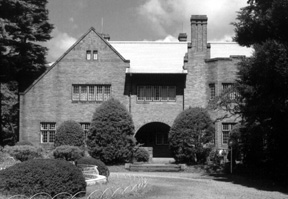
Seikado was established in 1892 with the objective of preserving the distinct cultural identity of Japan and Eastern countries, in a response to the Westernisation following the Meiji Restoration. It therefore aimed to buy old books and artefacts from China and Japan. In 1907, the institution purchased the entire collection of a Qing bibliophile which included Song and Yuan printed books, and this formed the foundation of the collection. Seikado Bunko was formed as a legal institution in 1940 and in 1948 temporarily became a section of the National Library.
Seikado Bunko has a collection of 8 volumes of fragmentary manuscripts and documents from Turfan and other Silk Road sites. These were purchased in 1935 from Chinese bookdealers in Japan. Seven of the eight volumes appear to have previously belonged to Liang Yushi, an official in Xinjiang.
The library is open Monday to Friday, 10am to 4.20pm, with a lunch break between 12-1pm. It is closed on public holidays and for a new year and summer break. Scholars from the level of university students may use the library with a letter of introduction. An appointment must be made in advance.
TENRI CENTRAL LIBRARY
Somanouchi 1050, Tenri, Nara 632
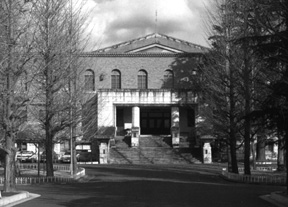
The establishment of Tenri Library was planned in 1925 and the building was completed in 1930. This new Central Library housed the various libraries of the Tenrikyo Buddhist Church and was originally intended as a facility for the education of overseas missionaries. It also housed research materials for faculty members and was open to readers in general as a public library.
The Library currently holds 1,780,000 books, manuscripts and documents, about a third of which are in Western languages, the rest in Japanese and Chinese. The Rare Books Collection comprises 17,000 items.
Tenri Library has about 20 scrolls from Silk Road sites, including the bulk of Zhang Daqian's collection and a manuscript identified by its postscripts as being discovered in the early 19th century in a stupa at Dunhuang. The manuscripts were acquired from various sources and include pieces in Tibetan, Xixia and Uighur. In addition, the Library has a Dunhuang and a Turfan painting from the Otani Expeditions.
Tenri Library is a public library and is open to anyone over the age of 15 years from 9am to 6pm from April to October, and 9am to 5pm from November to March. However, the Dunhuang manuscript collection is a closed collection and is only accessible on written request to the librarian in advance.
TOSHODAI TEMPLE
13-46 Gojo-cho, Nara City
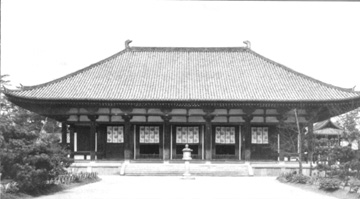
Toshodai Temple was founded by the Chinese priest, Ganjin, in 759 AD, dedicated to the Chinese Southern Chan (Zen) sect of Buddhism. It has been regarded as the headquarters of the Ritsu-shu denomination in Japan for more than 1200 years.
Toshodai Temple has a collection of about 27 manuscripts from Dunhuang and other Silk Road sites. In 1980 Toshodai Temple presented three manuscripts to the Chinese Buddhist Association.
TOKYO NATIONAL MUSEUM
Ueno Park, Taito-ku, Tokyo 110
Tokyo National Museum consists of four buildings on a site in Ueno Park that was originally the temple-residence of the Abbot of Kaneiji. The oldest building was completed in 1909 and displays archaeological objects. The central building, dating from 1937, houses Japanese art. The Treasure House was built in 1964 to house a collection of 319 works of art from the 7th-century Horyuku Temple in Nara. The fourth building, finished in 1968, is devoted to other Asian art and includes a display of Chinese calligraphy and a small Central Asian Gallery.
The Museum has a collection of 88,000 items and is one of the three National Museums in Japan (the others being in Kyoto and Nara).
One batch of items from the Otani Expeditions, which was purchased by the Japan Cultural Preservation Society in 1964, was moved to Tokyo National Museum in 1967. The collection includes artefacts from various sites in Xinjiang, manuscripts and woodslips from Turfan, Dunhuang and other sites in Chinese and Uygur, and paintings from Dunhuang and Turfan. The Museum also has a few items on an exchange agreement with Musèe Guimet and a few other items from Central Asia acquired separately.
Part of the collection of artefacts is on permanent display in the Central Asian gallery. The museum is open every day 9-4.30pm (although the Treasure Gallery only opens on Thursday) and there is an admission charge. The manuscripts and paintings are not generally on display but can be seen if a prior appointment is made with the curator.
ORIENTAL INSTITUTE, TOKYO UNIVERSITY
7-2-1 Hongo, Bunko-ku, Tokyo 113
The Oriental Institute has a collection of eleven manuscripts from Dunhuang and other Silk Road sites.
The manuscripts are not on display but may be seen by prior appointment in writing.
YURINKAN
Ensyoji-cho 44, Okazaki, Sakyo-ku, Kyoto 606-8344
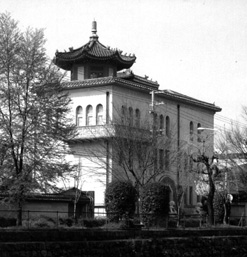
Yurinkan was established as a private museum in 1926 by Fujii Zensuke (1860-1934). He made a collection of Chinese artefacts and manuscripts, ranging from Shang dynasty bronzes to Qing costumes, but his collection of seals is most renowned. Yurinkan has a collection of about 100 manuscripts from silk road sites. 60 pieces were originally in the He collection, and there are other Dunhuang manuscripts from other sources. In addition, Yurinkan has 27 documents in languages other than Chinese, 23 in Uygur, but also Tibetan, Mongolian and Sanskrit.
The museum is open on the first and third Sunday of each month from 12 noon to 3pm. There are six manuscripts on display, five fragments in glass cases and a small booklet. Written requests to see other manuscripts not on display should be made in advance
On the Photography of Magistrate Wang and His Family
Wang Jiqing
A photograph entitled 'Magistrate Wang and His Family' was republished in IDP News 7 (Spring 1997), accompanying an excellent article by Professor Rong Xinjiang on Ye Changchi. A paragraph in the article explained the background to the photograph:
Wang Li'an was the Magistrate of Dunhuang County, namely Wang Zonghan. On his first visit to Dunhuang (1907), Stein had dealings with Magistrate Wang and included a photograph of the family in his personal narrative of his expedition, Ruins of Desert Cathay.
The conclusion that this was a photograph of Wang Li'an was drawn by Professor King Yung-hua of the Chinese Cultural University, Taipei, and Professor Rong, like many other scholars, evidently followed Professor King. Unfortunately, Professor King, having not examined the evidence, was wrong in his conclusion. In view that this mistake is constantly repeated by Dunhuang scholars, it seems a good opportunity to correct it here.
Who was the Magistrate of Dunhuang when Stein first visited that westernmost county of Gansu province in March-June, 1907? This seemingly trivial question has been held to be of vital importance by Chinese Dunhuang scholars who hold him responsible for the initial outflow of antiquities from to Europe. Stein himself simply called the magistrate 'Wang Ta-lao-ye' in Ruins of Desert Cathay (London, 1912) and Serindia (Oxford, 1921). In Stein's diary he was recorded as 'Wang-Daloi'. The photograph in question was first published as Fig. 209 of Ruins of Desert Cathay and was then captioned 'Wang Ta-lao-ye, Magistrate of Tun-huang, with his wife and mother.' In December 1983, Professor King published an article entitled 'Wang Zonghan: A Key Person in the Dispersal of Dunhuang Artefacts' (Hwa Kang Journal of Humanities, 15). Professor King asserted in his first sentence:
When Stein and Jiang Xiaowan [i.e. Chiang Ssu-yeh] arrived at Dunhuang in Guangxu 33 (1907), the Magistrate of Dunhuang was Wang Zonghan, namely Wang Tao-lao-ye recorded in the relevant work by Stein.
And his concluding sentence summarized the article as follows:
It was really a misfortune for Chinese academic circles that so capable and experienced a person as Wang Zonghan for some reason actually failed to discover Stein's plot.
In between, Professor King talked about Stein's accounts of 'Wang Ta-lao-ye' and some of the actual deeds of Wang Zonghan. He also reproduced the photograph, recaptioned as 'Wang Zonghan and his family'. He explained:
On June 13th (1907), Stein went to Wang Zonghan's place to make his farewells. Then Wang Zonghan's mother had just arrived at Dunhuang, so Stein took a photograph of the whole family.
The article was republished in a revised form but with the same first and last sentences in 1993, and the photograph was again included as Fig. 10 with the same caption ('Wang Zonghan' in A Study of the Principal Figures Relating to the Dispersal of Dunhuang Artefacts (Series of Dunhuang Introductory Studies: 10), Sin Wen Fong Publishers, Taipei, May 1993).
There is, however, no evidence at all that Stein had dealt with Wang Zonghan. On the contrary, a Chinese record prepared by Jiang Xiaowan now preserved in the Bodleian Library (Ms. Stein 341, folio unnumbered), indicated clearly that 'Wang Ta-lao-ye' was not Wang Zonghan but Wang Jiayan, Magistrate of Dunhuang County. In the margin of the record, Stein wrote 'Wang, Hsien-kuan, Tun-huang'. A manuscript book completed in 1941 by Lu Zhong (Lu Shaoqing), confirms this. This manuscript, now preserved in Gansu Provincial Library, Lanzhou, gives a list of the magistrates of Dunhuang County and their tenure of office based on the official records. The relevant section is summarized below:
| Name( Style) | Tenure of Office |
| Chen Wenguan (Ziqing) | Acting deputy in 1897 |
| Wu Xudi (Yueshen) Feb | 1901-Mar, 1902 |
| Wang Zonghan (Li'an) | Mar, 1902-Feb. 1906 |
| Huang Wanchun (Zhujun) | Mar 1906-Mar 1907 |
| Wang Jiayan (Shaoqing) | Mar 1907-July 1907 |
| Zhang Naicheng | From July 1907 |
Stein's own records also indicate that the Magistrate he visited was a newcomer. He noted in Ruins of Desert Cathay (Vol. II, p. 10) that on their arrival at Dunhuang on March 12, 1907:
only in the course of the morning did Chiang [Jiang Xiaowen] learn that a newly-arrived magistrate had taken over the seal of office the evening before.
According to Stein's other descriptions, this was certainly not Wang Zonghan, who had spent many years in Dunhuang before transferring to Lanzhou in 1906. It is therefore clear that 'Wang Ta-lao-ye' was, in fact, Wang Jiayan and not Wang Zonghan, as asserted by Professor King in his two articles.
As to the photograph, apart from Stein's explanation (Ruins of Desert Cathay, II, p. 234), there is another paragraph relating to its background in his diary of June 12, 1907, now in the Bodleian Library (MS. Stein 204, fol. 351):
See first Nan-Darin & then Wang Daloi. Another pleasant talk with refined scholar. He has smoothed my ways at An-shi & reassured Su-chou Tao-tai about my designs. His grey-haired mother, a dignified matron, sat for family group.
This diary entry proves that the photograph was taken by Stein on June 12, 1907, and was of Wang Jiayan and his family.
Wang Jiqing, Lanzhou University, is researching Stein's 4th expedition
Meeting on the Centenary of the Discovery of the Dunhuang Manuscript Cave
Rong Xinjiang
On 1 November, 1997, under the auspices of the Chinese National Cutural Bureau Chinese Culture Report, specialist scholars, journalists and those involved in the preservation of Dunhuang materials from Beijing were invited to the first meeting to discuss the Centenary of the Discovery of the Dunhuang Manuscript Cave, held at Peking University Shaoyuan Guest House. The meeting was chaired by Ma Shichang of Peking University Archaeology Department, and attended by the Beijing Dunhuang scholars Ji Xianlin, Su Bai, Chai Jianhong, Hao Chunwen, Zhao Heping, Deng Wenkuan, Zhang Yongquan, Li Chongfeng and Rong Xinjiang, and by Chen Juyu, Chairman of the Xiehe Group Inc., who have been ardent supporters of Dunhuang studies.
The Meeting agreed that the tens of thousands of manuscripts and almost one thousand silk paintings discovered by Wang Daoshi almost one hundred years ago, for which the millennium year will be the centenary, have enriched every aspect of Chinese history and culture in the past century. However, because the late Qing dynasty was corrupt and inefficient, from 1907 expeditions led by Stein, Pelliot, Otani and Oldenburg acquired the cave's treasures through unfair transactions and took them to London, Paris, Kyoto, St Petersburg and other places. From the standpoint of Chinese scholarship and in the words of the famous scholar, Professor Chen Yinke, this was a 'grevious history' (Preface to Dunhuang Jieyulu). Or, as expressed by the British writer, Peter Hopkirk: 'For these [Dunhuang mss.] are the very bones of a period of Chinese history which is poorly documented, and which Peking considers to be its rightful property.' ('Introduction', A. von Le Coq, Buried Treasures of Chinese Turkestan, Oxford 1988).
The Meeting thus expressed the hope of mounting a large scale exhibition in 2000 of Dunhuang manuscripts and paintings and related scholarship, and to invite both Chinese and foreign scholars to participate in an International Dunhuang Conference. Of course, the hope was also expressed that museums, libraries and private collections worldwide would take the opportunity afforded by this centenary to return the Dunhuang manuscripts and paintings to Dunhuang itself, so emulating the return of the Yongle dadian by the Soviet Union in the 1950s, and the more recent return of eight Dunhaung manuscripts by the private Japanese collector Aoyama Keiji.
The Meeting also discussed in detail the feasibility and the legal principles relating to the return of the Dunhuang manuscripts. The US barrister, Malcolm S. McNeil, engaged by Xiehe Group Inc., introduced the UN treaties concerning restitution of cultural items. The archaeologist, Professor Su Bai, particularly emphasised the intimate connection between the Dunhuang manuscripts and paintings, and the murals in the Mogao Caves, indicating the importance of the return of the manuscripts to Dunhuang for scholarship. At the same time, the Meeting set high store on the contribution made by institutions in England and France, etc. on the preservation of the manuscripts, along with the cordial relations over many years between Dunhuang scholars in China and abroad. The hope was expressed that the full details of the dispersal of the manuscripts and who was in the right and who in the wrong ought to be clarified first of all. It was also hoped that the demand for restitution be a formal request by the Chinese government, recognising that it is vital to follow due process of law. Xiehe Group Inc. offered their support for Dunhuang studies, the restitution and centenary activities.
Professor Rong Xinjiang, Peking University
Conferences
Pacific Neighbourhood Consortium Meeting 1998
12-14 May, 1998
Centre of Academic Activities
Academia Sinica, Taipei, Taiwan
Details: Professor Lewis Lancaster
Email: buddhst@socrates.berkeley.edu
Historical Sources of Eurasian and North African Civilsations
A Computer Approach
Second International Conference
2-6 June, 1998
Moscow, Russia
Details: Dimitry D. Vasilyev
Tel: +7 95 9285764
Email: dmivas@glas.apc.org
URL: http://www.orient.ru
International Convention of Asian Scholars (ICAS)
25-28 June 1998
De Leeuwenhorst, Noordwijkerhout
The Netherlands
Details: Helga Lasschuijt
ICAS Co-ordinator.
c/o IIAS
PO Box 9515
2300 RA Leiden
The Netherlands
Tel: +31 71 527 2227
Fax: +31 71 527 4162
Email: helgalass@rullet.leidenuniv.nl
URL: http://iias.leidenuniv.nl/conferences/icas/index.html
Permanent International Altaistic Conference
41st Meeting: Ancient Writing in the Altaic World
5-10 July, 1998
Helsinki, Finland
Details: PIAC
Goodbody Hall
Indiana University
Bloomington
Indiana 47405, USA
Fax: +1 812 855 7500
Email: sinord@indiana.edu
The Third Silk Road Conference
10-12 July, 1998
Yale University, USA
Email: valerie.hansen@yale.edu
International Seminar
Dunhuang Art and Society
22 June - 17 July, 1998
The SilkRoad Foundation and the Dunhuang Research Academy will sponsor and conduct a special seminar to be held at Dunhuang.
Details:
Fax: +1 408 867 8669
Email: alee@silk-road.com
International Symposium
The Civilization of the Western Region in Tang Dynasty: Anxi Big Supervisor's Office
held by China's Dunhuang Turfan Society and Xinjiang Kucha Caves Research Institute at Kizil Caves,Xinjiang, China
12 - 19 September, 1998
Details: He Fang
Fu 1, Xibeilu 132
Xinjiang Kucha Caves Research Institute
Urumqi, 830000
CHINA
Tel: +86 991 4837114
Fax: +86 991 4837114
Websites
http://kaladarshan.arts.ohio-state.edu/
The John C. and Susan L. Huntington Arcive of Buddhist and Related Art website
'The John C. and Susan L. Huntington Photographic Archive of Buddhist and Related Arts contains nearly 300,000 original color slides and b&w and color photographs of Asian art and architecture. Countries covered in the collection include India, Afghanistan, Pakistan, Bangladesh, Sri Lanka, Nepal, China, Japan, Thailand, Indonesia, and Myanmar (Burma). Works range from approximately 2500 B.C.E. to the present, and documentation includes contemporary religious activities in various parts of Asia. The Archive documents the art and architecture of these countries in situ, as well as works of art found in most major Asian, European, and American museums. This broad, yet detailed, collection contains predominantly Buddhist material, but also includes Hindu, Jain, Islamic, and other works.'
http://www.hm.tyg.jp/~acmuller/ebti.htm
The Electronic Buddhist Text Initiative (EBTI) website
'The Electronic Buddhist Text Initiative (EBTI) is a loose association of institutions and individuals involved in the input and processing of Buddhist texts in the electronic medium. It was founded in 1993 in Berkeley, California, and has rapidly gained momentum as more and more people realize the need to coordinate efforts and adopt compatible strategies in porting the Buddhist textual heritage to the electronic medium.'
http://www.silk-road.com
SilkRoad Foundation website
'The Silkroad Foundation is a non-profit organization, established in 1996, to promote the study and preservation of cultures and art on Inner Asia and the Silk Road.'
http://www.lzu.edu.cn/dunhuang/index.html
Painted statues of Dunhunag. Some digitized images.
http://www.textile-art.com/dun1.html
'DUNHUANG: Caves of the Singing Sands, Buddhist Art from the Silk Road'
High quality images with detailed descriptions.
List compiled by Colin Chinnery.
Publications
Journal of Dunhuang and Turfan Studies, Vol. 2
Following the appearance of the first issue of the Journal of Dunhuang and Turfan Studies in 1995, the second volume (1996) is now available. Below is a list of the main articles:
'A newly discovered Khotanese wooden document from Xinjiang' (Duan Qing and Wang Binghua)
'The nature of the Dunhuang library cave and the reason for its sealing' (Rong Xinjiang)
'An iconographical study on the painting of Tejaprabha Buddha' (Meng Sihui)
'New concordance of the numbering system of the Mogao Grottos' (Xu Ziqiang)
'From the Yihe coup d'etat to the Yanshou Reform: The political change in Gaochang during the late Qu period' (Meng Xianshi and Yao Congxin)
'The employment contracts unearthed from Dunhuang and Turfan' (Yang Jiping)
'Three rare fragments of Sun Zhenren Qianjinfang kept in Japan, Britain and Russia (Ma Jixing)
Both Chinese and European books are also reviewed in this volume.
For subscription orders please contact:
Peking University Press
100871 Beijing, China
Tel: +86 10 82752019
Fax: +86 10 62556201.
Report by Wang Bangwei, Peking University
Bulletin of the Asia Institute 9 (Sept. 1997)
The Bulletin carries scholarly articles, notes on museum acquisitions, review articles and reviews.
US$65 + US$7 shipping. Order from:
Bulletin of the Asia Institute
3287 Bradway Blvd
Bloomfield Hills
MI 48301
USA
Tel: +1 248 647 7917
Fax: +1 248 647 9223
Email: bai34@aol.com
URL: http://www.bulletinasiainstitute.org
AsianDOC Electronic Newsletter
Following discussions at ICANAS in Budapest (June, 1997) and subsequent e-mail correspondence, a new electronic newsletter is being initiated. Its purpose is to support scholars, librarians, and researchers world-wide who are developing text or image databases in the various fields of Asian/EurAsian Studies or who are incorporating materials in Asian languages into larger databases, and to promote better communication among them. Entitled AsianDOC Electronic Newsletter, it will be published quarterly (March, June, September, December) on the AsianDOC (Asian Database Online Community) takes its name from a mailing list which was initiated at the 1993 ICANAS in Hong Kong. In its early days it helped foster a sense of community among isolated scholars developing electronic resources for Asian and EurAsian Studies. The use of a web e-newsletter will be tried out on an experimental basis initially, with the first issue to be out before the Association for Asian Studies meeting in Washington (26-29 March 1998) and the second by the International Congress of Asian Scholars in Noordwijkerhout (25-28 June 1998). Discussion of the experimental issues will be on the agenda of the AAS Working Group for Electronic Resource Development and as well as at a special Meeting in Conjunction at ICAS.
This is a call for contributors and volunteers. Please send in material for the newsletter -- or volunteer to participate by coordinating a section of the newsletter, running an interest group, or writing a regular column.
For further details and a stylesheet contact:
Maureen H. Donovan
Associate Professor / Japanese Studies Librarian
The Ohio State University Libraries
328 Main Library, Columbus OH 43210-1286 USA
Tel: +1 614 292 3502
Fax: +1 614 292 1918
Email: donovan.1@osu.edu
East Asian Libraries Cooperative www: http://pears.lib.ohio-state.edu
Critical Edition of the British Collection of Dunhuang Documents
Work has begun on the Critical Edition of the British Collection of Dunhuang Documents, conducted by Professor Hao Chunwen of the China Capital Normal University. This is the first phase of the Critical Edition of Dunhuang Documents, a project devised by Professor Hao. The project's aim is to publish transcriptions of the Dunhuang documents, other than canonical Buddhist texts, in Chinese, British, French, Russian, Japanese and other collections using standard full form characters. The transcriptions will be accompanied by an explanation of the document's nature, dating, and other relevant information as well as a bibliography of related scholarship and research. The documents will be ordered in their library sequence.
Ever since the Dunhuang documents were discovered there have been great accomplishments in their organization and research through the efforts of scholars worldwide. However, compared with their cultural richness, the academic world's understanding of the documents is still far from thorough and a great amount of extremely valuable material has yet to receive the academic attention it deserves. There are many factors that have contributed to this situation, not least the fact that most of the documents are manuscripts and not always legible. Also, many Tang and Song period documents use local character forms and non-standard characters, and others are written in dialects from west of the Yellow River. All these factors have made it difficult for the average scholar to read the documents. Although there are several critical editions by subject, they ultimately fail to reflect the Dunhuang documents in their entirety.
Only by transcribing all the documents other than canonical Buddhist texts into standard full form characters can they become document material as easy to use as 'The Twenty-four Histories'. Seen in this light, compiling the Critical Edition of Dunhuang Documents is an important step in promoting the collection to the academic world. The preparatory work in compiling the Critical Edition of Dunhuang Documents is to examine international research of the past several decades on the Dunhuang documents. This is not only important for the transcription, but also means that readers can be provided with information from research, taking them to the forefront of scholarship on any given document. After nearly ten years, Professor Hao Chunwen and his assistants have completed the basic compilation work of Index of Research on Dunhuang Documents.
Building on this foundation, it is planned that the first volume of Critical Edition of the British Collection of Dunhuang Documents will be completed in 1998, and after that for one volume to be completed every year. We intend to publish and distribute Critical Edition of the British Collection of Dunhuang Documents in as a printed book and as a CD, the CD edition including both the originals and transcriptions. We hope that this project will receive the support of Dunhuang scholars throughout the world, and especially from those institutions with collections of Dunhuang material. We also hope that to obtain assistance from international funds for both research and publication.
For further details contact:
Professor Hao Chunwen
Department of History,
Capital Normal University
105 Xi Sanhuan Beilu
Beijing 100037
PEOPLE'S REPUBLIC OF CHINA
Tel: +86 10 68903561
Fax: +86 10 68903561
Email: HaoChunwen@ihw.com.cn
Report by Liu Yi, translated by Colin Chinnery
Project News
Preservation of Dunhuang and Central Asian Collections
Third International Conference
13-16 May, 1998
Berlin, Orientabteilung, Staatsbibliothek zu Berlin - Preussischer Kulturbesitz, and Museum für Indische Kunst, Staatliche Museen zu Berlin - Preussischer Kulturbesitz
For details contact:
Dr Hartmut-Ortwin Feistel
Tel: +49 - 30 - 266 24 15
Fax: +49 - 30 - 264 59 55
or Dr Simone-Christiane Raschmann
Tel: +49 30 20 16 60 56
Fax: +49 30 2 03 70-467
Email: (c/o) ziemepet@zedat.fu-berlin.de
People
Congratulations are owing to the Project Chairman, Abraham Lue. He was awarded a CMG (Companion of the Most Distinguished Order of St Michael and St George) on the recommendation of the Secretary of State for Foreign and Commonwealth Affairs, for services to UK-Chinese relations.
Wang Xu
We were deeply saddened to hear of the death of Wang Xu on November 26th 1997 in Peking. He was an internationally respected scholar, whose work on Chinese textiles and whose long association with the Institute of History of the Chinese Academy of Social Sciences are widely known. When he and Wang Yarong came to London in 1988-1989 to help us with the preparations for the publication of Ying cang Dunhuang wenxian, we derived great benefit from his knowledge and support. He impressed colleagues throughout the Library with his devotion to the task and the long hours that he worked in his determination to complete the project.
Though his scholarly work on Chinese textiles is admired throughout the world, we feel, like all those who knew him, particularly privileged. His remarkable courtesy, charm and kindness enhanced our lives. Everyone who met him, young or old, loved him. Despite his illness, he always kept in touch. Last Christmas he sent letters , and last year he also gave us copies of the revised edition of Shen Congwen's history of costume. We will never forget him and we will miss him dreadfully.
Frances Wood
New Project Staff Member
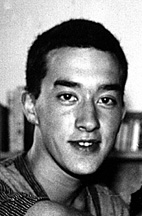
Colin Chinnery (pictured left) started work on the Project in London in January this year. He will be helping out on the day to day project administration and will also be responsible for the digitisation of the manuscripts for inclusion on the database. His appointment is funded by the UK Heritage Lottery Fund.
Grant
The Sino-British Fellowship Trust has generously awarded the Library an annual grant of £6000 per annum over three years in order to enable a series of scholars from China to work on the Dunhuang material.
